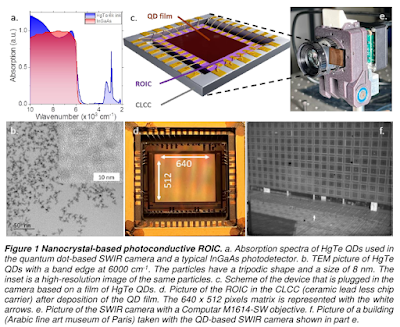The Institute of Nano Sciences from CNRS-Sorbonne University is currently researching and producing quantum dot materials of HgTe, sensitive in the extended SWIR wavelength range. Through a partnership with NIT, a first sensor-camera was produced.
This technology is promising to design low-cost and small pixel pitch focal plane array, as well as to expand the spectral range of the SWIR camera up to 2.5 µm.
This collaborative program is funded by the French National Research Agency.
This video presents the technology of quantum cascade detector (QCD) deposition with response up to 2um on NIT ROIC’s, and sample results images in various conditions.
A related paper titled "Photoconductive focal plane array based on HgTe quantum dots for fast and cost-effective short-wave infrared imaging" is in the June 2022 issue of Nanoscale journal.
Abstract: HgTe nanocrystals, thanks to quantum confinement, present a broadly tunable band gap all over the infrared spectral range. In addition, significant efforts have been dedicated to the design of infrared sensors with an absorbing layer made of nanocrystals. However, most efforts have been focused on single pixel sensors. Nanocrystals offer an appealing alternative to epitaxially grown semiconductors for infrared imaging by reducing the material growth cost and easing the coupling to the readout circuit. Here we propose a strategy to design an infrared focal plane array from a single fabrication step. The focal plane array (FPA) relies on a specifically designed readout circuit enabling in plane electric field application and operation in photoconductive mode. We demonstrate a VGA format focal plane array with a 15 μm pixel pitch presenting an external quantum efficiency of 4-5% (15 % internal quantum efficiency) for a cut-off around 1.8 μm and operation using Peltier cooling only. The FPA is compatible with 200 fps imaging full frame and imaging up to 340 fps is demonstrated by driving a reduced area of the FPA. In the last part of the paper, we discuss the cost of such sensors and show that the latter is only driven by labor costs while we estimate the cost of the NC film to be in the 10-20 € range.





It seems France is the country of quantum dots. There is another recent publication in this field - https://pubs.rsc.org/en/content/articlelanding/2022/RA/D2RA00048B about the production of carbon quantum dots out of brewery waste. It comes from Canada (Quebec where at least they speak french..) - i thought Belgium would be the place for research that links quantum dots with beer, but it seems this can be done in Canada as well ;-)
ReplyDeleteSuch a loose comment without any research.
Delete